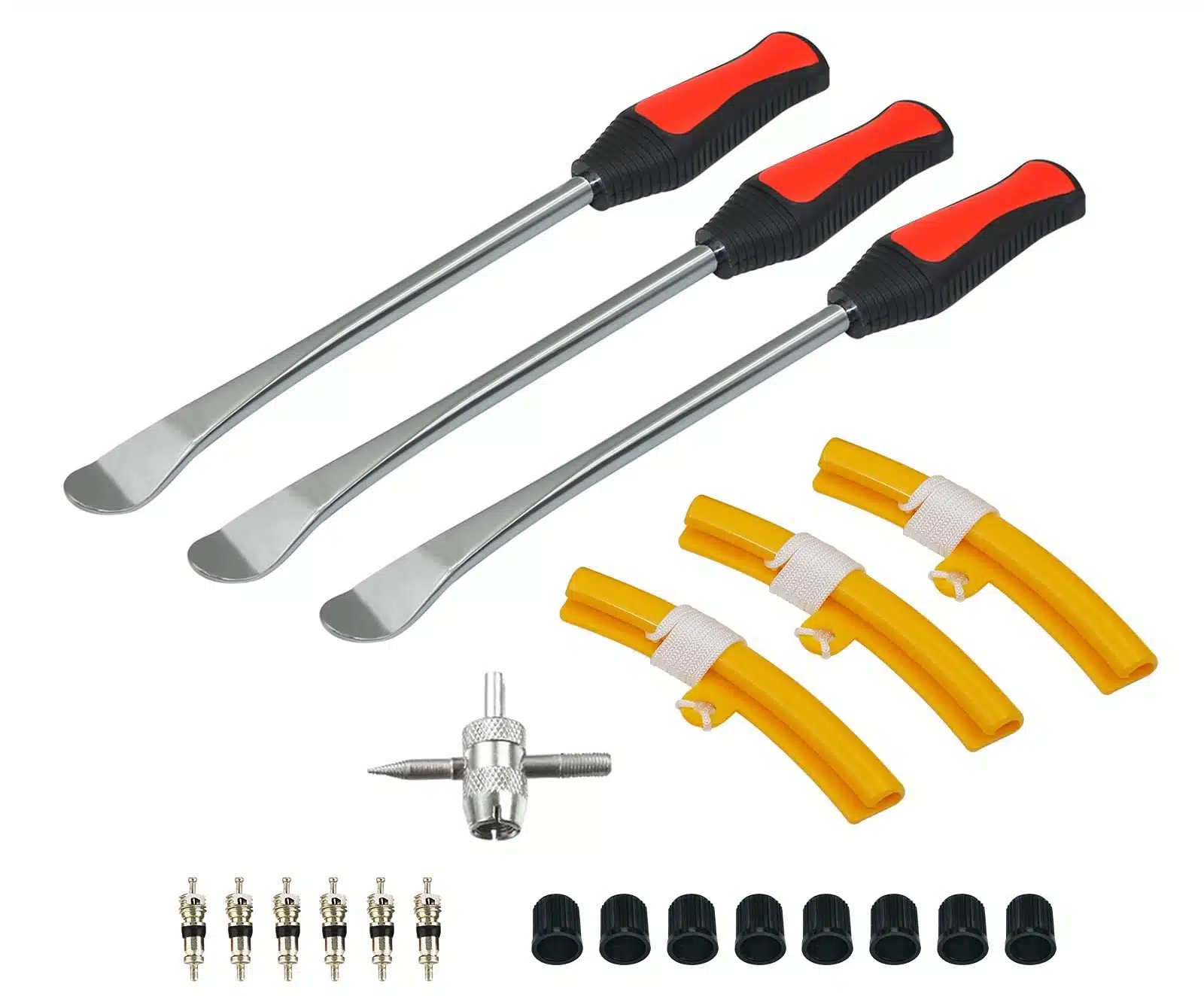Want your 4×4 truck or SUV tires to last longer?
Tire rotations are key, but many vehicle owners don’t know how to do them properly.
Uneven tire wear can lead to poor performance, reduced traction, and even safety issues on the road.
The good news is that you can easily rotate your tires at home with just a few simple tools.
This step-by-step guide will walk you through the process for 4×4 vehicles, including the rearward cross and X-patterns.
You’ll learn what tools you need, how to safely jack up your vehicle, and how often to rotate your tires.
By the end, you’ll be ready to tackle this essential maintenance task confidently.
What Is Tire Rotation?
Tire rotation is moving your vehicle’s tires from one position to another to ensure even wear.
This process helps tires wear uniformly, extending their lifespan and improving overall vehicle performance.
Importance of Tire Rotation
Regular tire rotations offer several benefits for your 4×4 vehicle:
- Extended tire life: Even wear helps tires last longer, saving you money on replacements.
- Improved vehicle performance: Properly rotated tires provide better traction, handling, and stability on various terrains.
- Enhanced safety: Evenly worn tires reduce the risk of blowouts and other tire-related issues that could jeopardize your safety on the road.
Types of Tires for 4×4 Vehicles
1. Directional Tires
These tires have a specific tread pattern designed for optimal performance when rotating in a particular direction.
They are marked with an arrow indicating the correct rotation direction.
When rotating directional tires, always maintain the indicated direction, moving them from front to back on the same side of the vehicle.
2. Non-Directional Tires
Also known as symmetrical tires, non-directional tires have a tread pattern that allows them to be mounted in any direction.
This flexibility enables various rotation patterns, such as the rearward cross or X-pattern, to promote even wear.
3. Staggered Sizes
Some 4×4 vehicles, particularly performance models, have different tire sizes on the front and rear axles.
This setup is called a staggered tire configuration.
When rotating staggered tires, it’s essential to keep the larger tires on the rear axle and rotate them from side to side, while the front tires can be rotated from side to side or front to back, depending on the vehicle’s requirements.
Preparation for Tire Rotation

Essential Tools
- Vehicle Jack: Used to lift your 4×4 off the ground for tire removal
- Lug Wrench: Required to loosen and tighten the lug nuts securing your wheels
- Torque Wrench: Ensures proper tightening of lug nuts to manufacturer specifications
- Wheel Chocks: Placed behind and in front of tires to prevent vehicle movement during rotation
Vehicle Preparation Safety Measures
Before lifting your vehicle, take these safety precautions:
- Park on a flat surface to ensure vehicle stability and prevent rolling.
- Engage the parking brake to secure the vehicle in place further.
- Place wheel chocks on both sides of the tires that will remain on the ground during lifting.
- Consult your vehicle’s manual to identify the recommended jacking points near each wheel well.
- Place the jack under the designated jacking point, ensuring it makes solid contact with the vehicle’s frame.
- As you lift the vehicle, continually check the jack’s stability and the vehicle’s balance to prevent accidents.
Properly preparing for your tire rotation and conducting a thorough inspection will ensure a safer and more effective maintenance process while catching potential issues early on.
Step-by-Step Tire Rotation Process
Step 1: Vehicle Preparation

-
- Park your 4×4 vehicle on a flat, level surface to ensure stability during the tire rotation.
- Engage the parking brake and place the transmission in either “Park” (for automatic vehicles) or first gear (for manual cars) to prevent the vehicle from rolling.
- Place wheel chocks on both sides of the front tires to provide extra stability and safety.
Step 2: Loosening Lug Nuts
-
- Before lifting the vehicle, use a lug wrench to loosen the lug nuts on all four wheels slightly.
- Turn the lug nuts counterclockwise to break their initial resistance, but do not remove them completely.
- Loosening the lug nuts while the tires are still on the ground prevents the wheels from spinning when you try to remove them later.
Step 3: Lifting the Vehicle

-
- Consult your vehicle’s owner’s manual to identify the proper jacking points on the undercarriage. These points are designed to support the vehicle’s weight safely.
- Place the jack under the designated jacking point closest to the tire you plan to remove first.
- Slowly lift the vehicle until the tire is about 6 inches off the ground.
- Place a jack stand under the appropriate lifting point near your raised tire. Ensure the jack stand is securely positioned and can support the vehicle’s weight.
- Repeat the lifting process on the opposite side of the vehicle, placing another jack stand under the designated lifting point.
Step 4: Rotating According to Pattern

For 4×4 vehicles, there are two primary tire rotation patterns.
1. Rearward Cross
- This pattern is suitable for 4×4 vehicles with non-directional tires.
- Remove the front tires and place them on the rear axle, keeping them on the same side of the vehicle.
- Remove the rear tires and cross them to the opposite side of the front axle (i.e., left rear to right front, right rear to left front).
2. X-Pattern
- This pattern is another option for 4×4 vehicles with non-directional tires.
- Remove the front left tire and place it on the rear right side.
- Remove the front right tire and place it on the rear left side.
- Remove the rear left tire and place it on the front right side.
- Remove the rear right tire and place it on the front left side.
3. Inclusion of Spare Tire (if applicable):
- If your 4×4 vehicle has a full-size spare tire that matches the other four tires, you can include it in the rotation pattern.
- Follow the chosen pattern (rearward cross or X-pattern) and place the spare tire in the position where the last tire was removed.
- Place the tire that would have gone into that position in the spare tire location.
Step 5: Re-attaching and Tightening Lug Nuts
- After placing each tire in its new position, hand-tighten the lug nuts to ensure they are properly seated.
- Once all tires are in place, use the lug wrench to tighten the lug nuts slightly. Do not fully tighten them at this point; it could cause uneven tightening when the vehicle is lowered.
Step 6: Lowering the Vehicle

- Using the jack, slightly lift the vehicle to remove the jack stands.
- Carefully lower the vehicle back to the ground, ensuring all four tires are in contact with the surface before completely lowering the jack.
- Once the vehicle is on the ground, use a torque wrench to tighten the lug nuts to the manufacturer’s specified torque settings. Tighten the lug nuts in a star pattern for even pressure distribution.
Post-Rotation Checklist
Tightening lug nuts to the correct torque specifications:
- Double-check the manufacturer’s recommended torque settings for your vehicle’s lug nuts.
- Use a torque wrench to ensure each lug nut is tightened to the proper specification.
- Over-tightening or under-tightening lug nuts can lead to wheel damage or dangerously loose wheels.
Checking and adjusting tire pressure:
- After the tire rotation, check the pressure in all four tires using a reliable tire pressure gauge.
- Adjust the tire pressure to the manufacturer’s recommended settings, which are found in the owner’s manual or on a sticker inside the driver’s side door jamb.
- Properly inflated tires ensure optimal performance, fuel efficiency, and tire longevity.
Test driving to ensure everything is set up correctly:
- After completing the tire rotation and checking tire pressure, take your vehicle for a short test drive in a safe area.
- Pay attention to any unusual vibrations, noises, or handling issues that may indicate an improperly installed tire or unbalanced wheel.
- Double-check the tire installation and lug nut tightness before driving further if you notice any issues.
Maintenance and Monitoring
Frequency of tire rotation
- Most vehicle manufacturers recommend rotating tires every 5,000 to 8,000 miles or every six months, whichever comes first.
- However, please consult your vehicle’s owner’s manual for specific recommendations, as some 4×4 cars may have different requirements based on their unique design or purpose.
Keeping records of rotations
- Maintain a log of your tire rotations, including the date and mileage at which each rotation was performed.
- This record-keeping helps you stay on track with your maintenance schedule and can be valuable if you need to make a warranty claim related to your tires.
- Many tire manufacturers require proof of regular rotations to honor tread life warranties.
Monitor Tire Wear and Recognize when Rotation Is Needed
- Regularly inspect your tires for uneven wear patterns, such as more wear on the inner or outer edges or flat spots in the center of the tread.
- Use a tire tread depth gauge to measure the tread depth at various points on each tire. Uneven tread depth across the tire may indicate the need for rotation.
- If you notice vibrations or pulling to one side while driving, it may be a sign that your tires need to be rotated or that there is an underlying issue with your vehicle’s alignment or suspension.
Conclusion
Tire rotation may seem daunting, but you can easily handle this essential maintenance job at home with the right tools, techniques, and patience.
Regularly rotating your 4×4 vehicle’s tires using the appropriate pattern for your tire type and drive system extends their lifespan, improves performance, and ensures a safer driving experience on any terrain.
Remember to keep records of your rotations and monitor your tires for uneven wear patterns.
If you found this guide helpful, check out our other 4×4 maintenance and off-road driving tips articles.
Remember to share your tire rotation experiences and tips in the comments below.
Happy rotating, and enjoy the adventures your well-maintained 4×4 will take you on!


